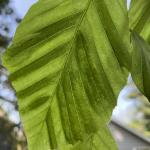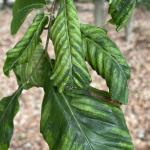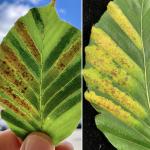Beech Leaf Disease
Pathogen
The foliar nematode Litylenchus crenatae ssp. mcannii (Lcm) is responsible for beech leaf disease (Carta et al. 2020) and is believed to be non-native in North America. Presently, it's suspected (but lacking confirmation) that the nematode is native to Japan.
History, Distribution and Hosts
Beech leaf disease (BLD) was first discovered in 2012 from northeastern Ohio (Ewing et al. 2019). In 2019, the disease was detected in southwestern Connecticut (Marra and Lamondia 2020) and several nearby counties in New York State. Currently, BLD has become firmly established across Connecticut, Rhode Island and Massachusetts. In addition, BLD continues to spread northward through Maine, New Hampshire and Vermont. This is especially concerning in areas where the northern hardwood (beech-birch-maple) forest type dominates. Many northern hardwood forests in western Massachusetts are primarily composed of American beech (Fagus grandifolia). According to the most recent USFS forest inventory and analysis, there are nearly 141 million American beech in Massachusetts, representing just under 10% of all forest trees >1" in diameter (USDA Forest Service 2020). Prior to BLD, no foliar nematode has ever been known to cause a disease of a forest tree that results in mortality (Carta et al. 2020). While uncertainty lingered for many years as to the cause of BLD, research has clearly linked the presence of the nematode to symptom development in natural and inoculated beech (Carta et al. 2020). American (F. grandifolia), European (F. sylvatica), Japanese (F. crenata) and Oriental beech (F. orientalis) are known hosts.
Symptoms & Life Cycle
Symptoms of BLD appear as: (i) dark-colored, interveinal banding on the foliage; (ii) cupping, curling and distortion of the foliage; (iii) thickening of the leaves and a general "leathery" texture; (iv) premature leaf shedding; and (v) death of the buds and subsequent branch dieback resulting in death of the tree. The interveinal banding is often dark green in color. The interveinal banding, cupping and distortion of the foliage may be caused by toxins, pectinases, phenolics or caretonoids produced by the nematode (Cara et al. 2020). It’s hypothesized that thicker, darker leaf tissue may protect the nematode against UV light and provide a larger number of cells for feeding.
Lcm invades beech buds from mid-summer into autumn (roughly late June into October), where they feed and overwinter (Reed et al. 2020). They likely have many vectors with birds and insects providing the best means of dispersal. It is within the buds that the damage takes place. During the late autumn and winter months, Lcm populations are high within infested beech buds (Reed et al. 2020). When disease severity is minor to moderate, symptomatic leaves emerge the following spring. When disease severity is high, buds are killed outright and no new leaves and shoots are produced. Nematode eggs produced within the buds are dispersed during budbreak and leaf expansion and may scatter throughout the canopy on splashing rainwater and wind. They can survive for long periods until sufficient moisture allows for hatching. Very large populations of nematode eggs exist within the aborted buds. When infested trees flush symptomatic foliage in the spring, a second flush of leaves may also occur. This second flush of foliage is disease free, but often stunted and unevenly produced through the canopy.
Numerous studies are investigating the vectors of BLD, disease etiology and management of the nematode. Much remains to be learned about this new and destructive disease. While initial reports from the Midwest suggested that mature trees could withstand the disease for many years (Ewing et al. 2019), trees in southern New England are dying rapidly after infection. Additional stresses such as drought, winter injury, site-related stresses (poor, compacted soils and physical injury), twig/branch cankering fungi (e.g. Asterosporium, Botryosphaeria, Nectria, Phomopsis, etc.), ambrosia beetle infestation, and other insects pests and pathogens all help to accelerate the decline of infested trees.
Management
Foliar Nematicide Spray: Trials and reports indicate the locally systemic nematicide fluopyram can provide some level of BLD control but uncertainty exists regarding the optimal time for application. Lcm has overlapping generations, meaning that eggs, juveniles and adults may all be present within infected buds and leaves. In addition, eggs can be dispersed during budbreak and leaf expansion and may be present on twigs and branches, waiting for moisture to hatch and develop. Any time an organism has staggered development, chemical intervention must be timed correctly for maximum control. Reports and observations are suggesting that early season applications of fluopyram may be the most effective in controlling BLD. Specifically, applications made once leaves are fully formed in June and July. Because the nematodes emerge from infested foliage and migrate to the buds from roughly late June into October (Reed et al. 2020), early season applications will target the nematodes before they migrate to the buds. If the first application is made later in the summer (e.g. August), nematodes migrating in July may have successfully reached the buds where they can overwinter and cause damage.
Presently, there is still uncertainty over whether fluopyram will kill Lcm eggs. Fluopyram has efficacy against certain plant parasitic nematodes, but for some, it does not kill the eggs (Schleker et al. 2022). If applications are made early in the growing season and the eggs survive, the treatment would not be fully effective. However, the risk can be buffered by multiple applications of fluopyram made on 21 day intervals. There is a moderate risk of resistance development when using fluopyram. That means to avoid resistance development, fluopyram should be rotated with another nematicide. However, at present, another nematicide labeled for use on trees with potential efficacy has not be identified. However, given that the majority of the Lcm population is spreading from forest settings where they would never encounter a nematicide suggests that at this time, the risk of resistance development is not a major concern when designing BLD treatment regimes.
Two commercial products formulated for use on woody plants are available. The first is Broadform, a combination product composed of fluopyram + trifloxystrobin. The Broadform label covers residential and commercial landscapes and "ornamental" hosts, including all species of beech (Fagus). Additionally, the supplemental Broadform 2ee covers recommendations to manage BLD, with a rate of 8 fl. oz./100 gal and an application interval of 7-14 days. Current trials suggest that lower rates of application (i.e. 2-4 fl. oz. /100 gal) may provide the same level of control and that a 21 day interval is better suited for treatment given the staggered emergence of adult nematodes. The 2ee recommendation for BLD covers Massachusetts, Connecticut, Rhode Island, New Hampshire, Vermont and Maine. The second product is Luna Experience, another combination product (fluopyram + tebuconazole) labeled for use on woody plants (including beech). However, Luna Experience is labeled only for agriculture use and not for woody ornamentals. Currently, Connecticut has an emergency use order allowing the use of Luna Experience on beech in residential and commercial landscape settings. Massachusetts does not have this emergency use exemption. Finally, Indemnify is a single fluopyram product but is labeled for use on turf only.
Systemic Nematicide Injection: Arbotect 20-S (thiabendazole hyophosphite) was given a 24(c) special local needs label in Massachusetts that permits its use for control of BLD on beech (Fagus spp.). Additional states with this supplemental label include CT, NY, NJ, OH, PA, RI, VA, and VT. The label recommends 2.8 fl. oz. of Arbotect 20-S for every 5" of trunk diameter on smaller trees and up to 12 fl. oz. per 5" of trunk diameter for larger trees. Injections should be made on the root flare only after the foliage is fully hardened off for the season (approximately mid-June onward in MA). Trees can be injected once every two years. Additional details of the SLN label can be found here: https://www.greenbook.net/syngenta-llc/arbotect-20-s
Phosphites: Soil or lower trunk application of phosphites (mono- and di-potassium salts of Phosphorous acid) may provide some level of BLD control, although results can vary considerably. A notable improvement in tree vigor may take several years of regular treatments. Phosphites have two modes of action: (1) through direct antifungal activity when applied in high concentrations; and (2) by stimulating the tree’s natural defense response (Thao and Yamakama 2009). The first mode of action likely has no value since BLD is caused by a nematode and not a fungus. However, the second mode of action, natural defense stimulation, may be how phosphites help to induce some level of disease resistance within infected beech. Phosphites have been used previously to control plant parasitic nematodes with mixed results. Reports and observations in Massachusetts suggest that phosphites provide limited control of BLD on landscape trees. However, phosphites may still be useful in aiding in the control of other stresses, such as cankering fungi like Nectria cinnabarina (coral spot canker).
Cultural: There are no cultural practices that can limit the spread and severity of BLD. Because the primary vectors of BLD are birds and insects, management aimed at limiting disease spread is not possible. There are no quarantine zones or best management practices associated with the disposal of infested beech material. Once BLD establishes in an area, it cannot be eradicated by the removal of one infested tree. BLD can move on nursery stock, therefore any beech stock should be carefully examined prior to purchase and planting. At this time, new plantings of American and European beech are not recommended.
References
Carta L.K., Handoo Z.A., Li S., et al. 2020. Beech leaf disease symptoms caused by newly recognized nematode subspecies Litylenchus crenatae mccannii (Anguinata) described from Fagus grandifolia in North America. Forest Pathology, 50: e12580. https://doi.org/10.1111/efp.12580
Ewing C.J., Hausman C.E., Pogacnik J., Slot J., Bonello, P. 2019. Beech leaf disease: An emerging forest epidemic. Forest Pathology 49: e12488. https://doi.org/10.1111/efp.12488
Marra, R.E. and LaMondia, J. 2020. First report of Beech Leaf Disease, caused by the foliar nematode, Litylenchus crenatae mccannii, on American Beech (Fagus grandifolia) in Connecticut. Plant Disease, 104(9). https://doi.org/10.1094/PDIS-02-20-0442-PDN
Reed, S.E., Greifenhagen, S., Yu, Q., et al. 2020. Foliar nematode, Litylenchus crenatae ssp. mccannii, population dynamics in leaves and buds of beech leaf disease-affected trees in Canada and the US. Forest Pathology, 50: e12599. https://doi.org/10.1111/efp.12599
Scheleker, A.S.S., Rist, M., Matera, C., et al. 2022. Mode of action of fluopyram in plant‑parasitic nematodes. Scientific Reports 12: 11954. https://doi.org/10.1038/s41598-022-15782-7
Thao, H.T.B. and Yamakawa, T. 2009. Phosphite (phosphorous acid): Fungicide, fertilizer or bio-stimulator? Soil Science and Plant Nutrition, 55(2): 228–234. https://doi.org/10.1111/j.1747-0765.2009.00365.x
USDA Forest Service. 2020. Forests of Massachusetts, 2019. Resource Update FS-239. Madison, WI: U.S. Department of Agriculture Forest Service, Northern Research Station. 2 p. https://doi.org/10.2737/FS-RU-239







